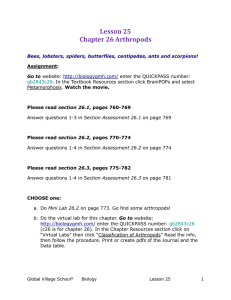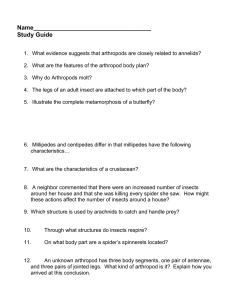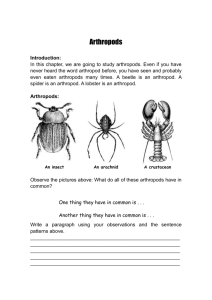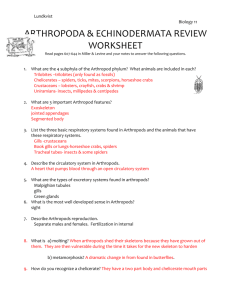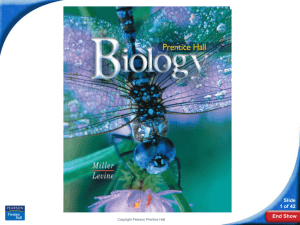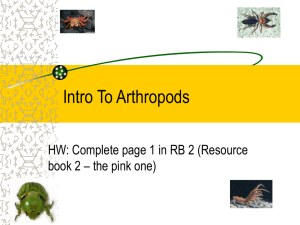–2 Groups of 28 Arthropods Slide
advertisement
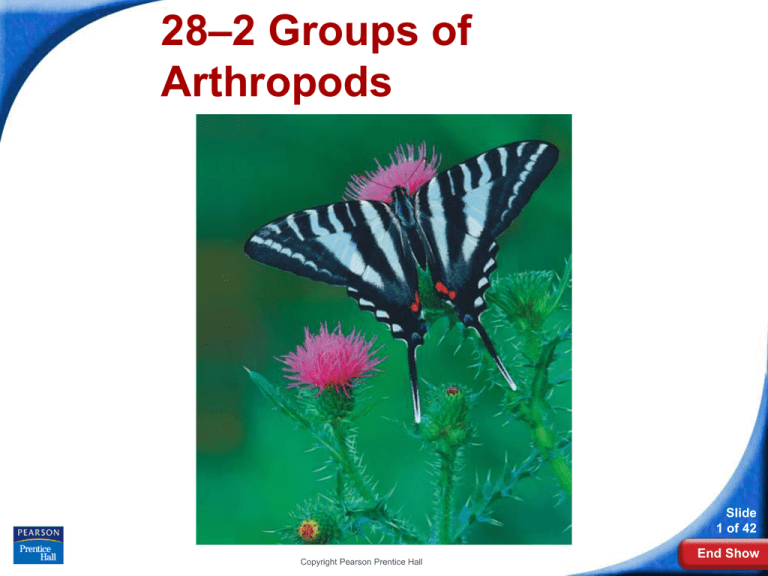
28–2 Groups of Arthropods Slide 1 of 42 Copyright Pearson Prentice Hall End Show 28–2 Groups of Arthropods 28–2 Groups of Arthropods Arthropods are classified based on the number and structure of their body segments and appendages— particularly their mouthparts. The three major groups of arthropods are: • crustaceans • spiders and their relatives • insects and their relatives Slide 2 of 42 Copyright Pearson Prentice Hall End Show 28–2 Groups of Arthropods Crustaceans Crustaceans Subphylum Crustacea Primarily aquatic. Includes crabs, shrimps, lobsters, crayfishes, and barnacles Range in size from small terrestrial pill bugs to enormous spider crabs (20kg) Slide 3 of 42 Copyright Pearson Prentice Hall End Show 28–2 Groups of Arthropods Crustaceans Crustaceans typically have two pairs of antennae, two or three body sections, and chewing mouthparts called mandibles. Abdomen Cephalothorax Mandible First antenna Second antenna Slide 4 of 42 Copyright Pearson Prentice Hall End Show 28–2 Groups of Arthropods Crustaceans The crayfish has a body plan that is typical of many crustaceans. The anterior cephalothorax is formed by fusion of the head with the thorax, which lies right behind the head and holds most internal organs. Cephalothorax Slide 5 of 42 Copyright Pearson Prentice Hall End Show 28–2 Groups of Arthropods Crustaceans The abdomen is the posterior part of the body. The carapace is the part of the exoskeleton that covers the cephalothorax. Abdomen Carapace Slide 6 of 42 Copyright Pearson Prentice Hall End Show 28–2 Groups of Arthropods Crustaceans The first two pairs of appendages are antennae. They have many sensory hairs. In crayfish, antennae are primarily sense organs and in other crustaceans, they are used for filter feeding or swimming. First antenna Second antenna Slide 7 of 42 Copyright Pearson Prentice Hall End Show 28–2 Groups of Arthropods Crustaceans The third pair of appendages are the mandibles. A mandible is a mouthpart adapted for biting and grinding food. Gills are attached to appendages of the cephalothorax. Mandible Slide 8 of 42 Copyright Pearson Prentice Hall End Show 28–2 Groups of Arthropods Crustaceans Decapods, like crayfishes, lobsters, and crabs, have five pairs of legs. In crayfishes, the first pair of legs, called chelipeds, have large claws that catch, pick up, crush, and cut food. Walking legs Copyright Pearson Prentice Hall Cheliped Slide 9 of 42 End Show 28–2 Groups of Arthropods Crustaceans Behind these legs are four pairs of walking legs. Along the abdomen are several pairs of swimmerets, which are flipperlike appendages used for swimming. Swimmerets Walking legs Copyright Pearson Prentice Hall Cheliped Slide 10 of 42 End Show 28–2 Groups of Arthropods Crustaceans The final abdominal segment is fused with a pair of paddle-like appendages to form a large, flat tail. When abdominal muscles contract, the tail snaps beneath the body of the crayfish, pushing it backwards. Tail Slide 11 of 42 Copyright Pearson Prentice Hall End Show 28–2 Groups of Arthropods Barnacles Barnacles are another group of crustaceans. They are sessile, attached to a single spot. They have lost their abdominal segments and no longer use mandibles. Because of their outer shell-like coverings, they were once classified as mollusks. They use their appendages to capture and draw food particles into their mouths. Slide 12 of 42 Copyright Pearson Prentice Hall End Show 28–2 Groups of Arthropods Spiders and Their Relatives Spiders and Their Relatives Subphylum Chelicerata Horseshoe crabs, spiders, ticks, and scorpions are chelicerates. Chelicerates lack antennae. Chelicerates have mouthparts called chelicerae and two body sections (cephalothorax and abdomen), and nearly all have four pairs of walking legs. The cephalothorax contains the brain, eyes, mouth, and walking legs. The abdomen contains most of the internal organs. Slide 13 of 42 Copyright Pearson Prentice Hall End Show 28–2 Groups of Arthropods Spiders and Their Relatives Chelicerates have two pairs of appendages attached near the mouth that are adapted as mouthparts. One pair, called chelicerae, contain fangs and are used to stab and paralyze prey. Fanglike chelicera Copyright Pearson Prentice Hall Slide 14 of 42 End Show 28–2 Groups of Arthropods Spiders and Their Relatives The other pair, called pedipalps, are longer than the chelicerae and are usually modified to grab prey. Pedipalp Slide 15 of 42 Copyright Pearson Prentice Hall End Show 28–2 Groups of Arthropods Spiders and Their Relatives Chelicerates respire using book gills or book lungs. Horseshoe crabs move water across book gills and terrestrial chelicerates use spiracles to gain air which then circulates across surfaces of the book lung. Slide 16 of 42 Copyright Pearson Prentice Hall End Show 28–2 Groups of Arthropods Spiders and Their Relatives Chelicerates are divided into two main classes. • Merostomata includes horseshoe crabs. • Arachnida, or arachnids, includes spiders, mites, ticks, and scorpions. Slide 17 of 42 Copyright Pearson Prentice Hall End Show 28–2 Groups of Arthropods Spiders and Their Relatives Horseshoe Crabs Horseshoe crabs first appeared more than 500 million years ago and have changed little since that time. They are heavily armored like crabs, but have an anatomy closer to that of spiders. They have chelicerae, five pairs of walking legs, and a long spike-like tail that is used for movement. They are common along marshes and shallow bays of the eastern United States coast. Slide 18 of 42 Copyright Pearson Prentice Hall End Show 28–2 Groups of Arthropods Spiders and Their Relatives Spiders Spiders capture and feed on animals ranging from other arthropods to small birds. Some spiders spin webs of a strong, flexible protein called silk, which they use to catch flying prey. Others stalk and then pounce on their prey, like a tarantula. Some spiders lie in wait beneath a camouflaged burrow and leap out to grab insects that venture too near. Slide 19 of 42 Copyright Pearson Prentice Hall End Show 28–2 Groups of Arthropods Spiders and Their Relatives Spiders do not have jaws for chewing, so they must liquefy their food to swallow it. Once a spider captures its prey, it uses fanglike chelicerae to inject paralyzing venom into it. When they prey is paralyzed, the spider injects digestive enzymes into the wounds, which break down the prey’s tissues. The specialized pumping stomach forces the liquefied food through the rest of the digestive system. Slide 20 of 42 Copyright Pearson Prentice Hall End Show 28–2 Groups of Arthropods Spiders and Their Relatives All spiders produce silk, which is much stronger than steel! Spiders spin silk into webs, cocoons for eggs, and wrappings for prey. Silk glands Copyright Pearson Prentice Hall Slide 21 of 42 End Show 28–2 Groups of Arthropods Spiders and Their Relatives They do this by forcing liquid silk through spinnerets, which are organs that contain silk glands. As the silk is pulled out, it hardens into a single strand. Spinnerets Slide 22 of 42 Copyright Pearson Prentice Hall End Show 28–2 Groups of Arthropods Spiders and Their Relatives Mites and Ticks Mites and ticks are small arachnids that are often parasitic. Their chelicerae and pedipalps are specialized for digging into a host’s tissues and sucking out blood or plant fluids. Chelicerae are usually the needlelike structures used to pierce the skin of the host. The pedipalps are equipped with claws for attaching. Their mouthparts are so strong that if a tick begins to feed on you and you try to pull it off, its cephalothorax may separate and remain in your skin! Ticks transmit bacteria that cause serious diseases. Slide 23 of 42 Copyright Pearson Prentice Hall End Show 28–2 Groups of Arthropods Spiders and Their Relatives Scorpions Scorpions inhabit warm areas around the world. Scorpions have pedipalps that are enlarged into claws. The long segmented abdomen carries a venomous stinger that can paralyze or kill prey. Scorpions chew their prey using chelicerae. Slide 24 of 42 Copyright Pearson Prentice Hall End Show 28–2 Groups of Arthropods Insects and Their Relatives Insects and Their Relatives Subphylum Uniramia: contains more species than all other groups of animals alive today. Centipedes, millipedes, and insects are uniramians. Uniramians have jaws, one pair of antennae, and unbranched appendages. Slide 25 of 42 Copyright Pearson Prentice Hall End Show 28–2 Groups of Arthropods Insects and Their Relatives Centipedes Class Chilopoda Long, worm-like bodies with many leg bearing segments. Have from a few to more than 100 pairs of legs. Most body segments bear one pair of legs each. Carnivores whose mouthparts contain venomous claws that they use to catch and stun or kill their prey. Live beneath rocks or in soil. Spiracles cannot close and their exoskeleton is not waterproof; restricted to moist or humid areas. Copyright Pearson Prentice Hall Slide 26 of 42 End Show 28–2 Groups of Arthropods Insects and Their Relatives Millipedes Class Diplopoda Highly segmented body. Each segment bears two pairs of legs. Live under rocks and decaying logs. Millipedes defend themselves by rolling up into a ball or by secreting unpleasant or toxic chemicals. They feed on dead and decaying plant material. Slide 27 of 42 Copyright Pearson Prentice Hall End Show

